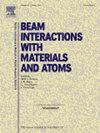The combination of free flying distance grouping method and midpoint method for high accuracy and high efficiency in Monte Carlo simulations of electron-solid interactions
IF 1.4
3区 物理与天体物理
Q3 INSTRUMENTS & INSTRUMENTATION
Nuclear Instruments & Methods in Physics Research Section B-beam Interactions With Materials and Atoms
Pub Date : 2025-01-31
DOI:10.1016/j.nimb.2025.165625
引用次数: 0
Abstract
Recently, a method to accelerate computational efficiency by orders of magnitude for Monte Carlo simulations of electron-solid interactions has been proposed as the computation engine for the open-source code AMCSET. The method combines consecutive free-flying distances into groups for scattering simulations, assuming equal energy within each group. However, questions regarding accuracy have arisen. If the electron energy at the start of the group is used for the entire group, it can lead to noticeable errors. The error can be avoided by applying the midpoint method, where the average of the starting and ending electron energies within a group is used for scattering calculations. While this energy midpoint selection seems like an obvious choice, this study reports a computational method to predict the energy midpoint of the next group by using the energy loss from the current group, provided the group size is sufficiently large. Thus, the midpoint is calculated explicitly.
将自由飞行距离分组法与中点法相结合,实现了电子-固体相互作用蒙特卡罗模拟的高精度和高效率
最近,提出了一种将电子-固体相互作用蒙特卡罗模拟的计算效率提高几个数量级的方法,作为开源代码AMCSET的计算引擎。该方法将连续的自由飞行距离组合成组进行散射模拟,并假设每组内能量相等。然而,关于准确性的问题已经出现。如果将基团起始处的电子能量用于整个基团,则可能导致明显的误差。这种误差可以通过应用中点法来避免,该中点法使用组内起始和结束电子能量的平均值进行散射计算。虽然这种能量中点选择似乎是一个显而易见的选择,但本研究报告了一种计算方法,只要群体规模足够大,就可以利用当前群体的能量损失来预测下一群体的能量中点。因此,中点是显式计算的。
本文章由计算机程序翻译,如有差异,请以英文原文为准。
求助全文
约1分钟内获得全文
求助全文
来源期刊
CiteScore
2.80
自引率
7.70%
发文量
231
审稿时长
1.9 months
期刊介绍:
Section B of Nuclear Instruments and Methods in Physics Research covers all aspects of the interaction of energetic beams with atoms, molecules and aggregate forms of matter. This includes ion beam analysis and ion beam modification of materials as well as basic data of importance for these studies. Topics of general interest include: atomic collisions in solids, particle channelling, all aspects of collision cascades, the modification of materials by energetic beams, ion implantation, irradiation - induced changes in materials, the physics and chemistry of beam interactions and the analysis of materials by all forms of energetic radiation. Modification by ion, laser and electron beams for the study of electronic materials, metals, ceramics, insulators, polymers and other important and new materials systems are included. Related studies, such as the application of ion beam analysis to biological, archaeological and geological samples as well as applications to solve problems in planetary science are also welcome. Energetic beams of interest include atomic and molecular ions, neutrons, positrons and muons, plasmas directed at surfaces, electron and photon beams, including laser treated surfaces and studies of solids by photon radiation from rotating anodes, synchrotrons, etc. In addition, the interaction between various forms of radiation and radiation-induced deposition processes are relevant.

 求助内容:
求助内容: 应助结果提醒方式:
应助结果提醒方式:


